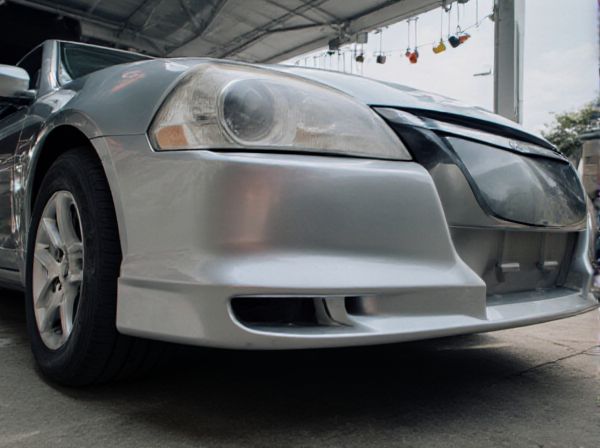
Photo illustration: Roll pan bumper vs Standard bumper
A roll pan bumper offers a smooth, sleek design that enhances the vehicle's aesthetics while minimizing damage during low-speed impacts. Standard bumpers provide more robust protection with visible reinforcement, often better suited for heavy-duty use or off-road conditions. Choosing the right bumper depends on your preference for style versus maximum impact resistance.
Table of Comparison
| Feature | Roll Pan Bumper | Standard Bumper |
|---|---|---|
| Design | Sleek, smooth, wraps around rear | Bulky, conventional, protruding shape |
| Material | Steel or aluminum with powder coating | Plastic or chrome-plated steel |
| Durability | High impact resistance, corrosion resistant | Moderate impact resistance, prone to dents |
| Aerodynamics | Improved airflow, reduces drag | Standard airflow, higher drag coefficient |
| Weight | Lighter than standard bumpers | Heavier due to bulkier materials |
| Installation | Requires custom fitting | Direct replacement, easy install |
| Cost | Higher upfront price | Lower cost, widely available |
| Appearance | Custom, smooth finish enhances look | Standard factory look |
Introduction to Roll Pan Bumpers vs Standard Bumpers
Roll pan bumpers offer a smooth, streamlined design that enhances vehicle aesthetics by replacing the bulky appearance of standard bumpers. Unlike standard bumpers, which have prominent edges and corners, roll pan bumpers extend seamlessly along the rear, improving aerodynamics and providing a custom-built look. Commonly used in trucks and custom vehicles, roll pan bumpers also facilitate easier integration of license plates and lighting while maintaining durable protection.
Design Differences: Roll Pan vs Standard Bumpers
Roll pan bumpers feature a smooth, continuous design that wraps seamlessly around the rear of a vehicle, providing a sleek, streamlined appearance compared to the segmented and protruding structure of standard bumpers. Standard bumpers typically include distinct edges, corners, and mounting brackets that create a more utilitarian and angular look, often leaving exposed hardware and gaps. The roll pan's design emphasizes aerodynamic efficiency and aesthetic integration, while standard bumpers prioritize practicality and ease of replacement.
Aesthetic Appeal: Which Looks Better?
Roll pan bumpers offer a sleek, smooth, and streamlined appearance by eliminating the traditional bumper's separate look, creating a more integrated and modern aesthetic on trucks and SUVs. Standard bumpers maintain a classic and rugged design, often with visible hardware and edges that emphasize utility rather than style. Preference for aesthetic appeal depends on whether the vehicle owner prioritizes contemporary minimalism or traditional toughness in their vehicle's exterior design.
Installation Process: Roll Pan vs Standard Bumper
The installation process of a roll pan bumper typically requires more precise alignment and may involve modifications to the vehicle's mounting points to achieve a seamless, custom fit, enhancing the vehicle's aesthetic appeal. In contrast, a standard bumper installation is generally more straightforward, using existing factory mounting brackets and hardware, making it quicker and easier for most DIY enthusiasts or professional technicians. While roll pan bumpers offer a sleeker look, their installation demands greater attention to detail and potential welding or cutting, unlike the bolt-on simplicity of standard bumpers.
Material and Durability Comparison
Roll pan bumpers are typically made from high-strength steel or aluminum, providing enhanced resistance to impacts and corrosion compared to standard bumpers, which often use basic steel or plastic composites. The seamless design of roll pan bumpers enhances structural integrity and reduces the risk of cracks or dents, whereas standard bumpers with segmented parts are more prone to damage under heavy stress. Durability testing shows roll pan bumpers maintain their shape and protective qualities longer in harsh environments, making them a superior choice for off-road and heavy-duty applications.
Impact on Vehicle Performance and Safety
Roll pan bumpers enhance vehicle aerodynamics by offering a smoother, streamlined surface compared to standard bumpers, reducing drag and slightly improving fuel efficiency. Their lower profile design minimizes damage in low-speed impacts but may provide less protection against severe collisions than standard bumpers with reinforced beams. Safety performance varies as roll pan bumpers often lack the energy-absorbing properties found in traditional bumpers, possibly affecting crash impact mitigation.
Cost Analysis: Initial and Long-Term Expenses
Roll pan bumpers typically have a higher initial cost due to specialized materials and manufacturing processes, while standard bumpers are generally more affordable upfront. Long-term expenses for roll pan bumpers tend to be lower because of their enhanced durability and resistance to damage, reducing repair and replacement frequency. Maintenance costs for standard bumpers can accumulate over time due to increased susceptibility to dents and rust, impacting overall value.
Customization Options for Each Bumper Type
Roll pan bumpers offer extensive customization options, including integrated lighting, smooth contours for a sleek appearance, and tailored paint finishes that blend seamlessly with the vehicle's body. Standard bumpers provide more straightforward customization choices, such as add-on guards, chrome plating, and a variety of colors, but typically lack the seamless, molded look of roll pan designs. Vehicle owners seeking a modern, aerodynamic upgrade often prefer roll pan bumpers for their adaptable styling, while those prioritizing cost-effective and practical modifications may lean toward standard bumpers.
Street Legality and Compliance Considerations
Roll pan bumpers often meet street legality requirements by maintaining smooth, contoured designs that comply with state and federal regulations regarding pedestrian safety and crash standards. Standard bumpers typically adhere to established height and impact absorption criteria outlined by the National Highway Traffic Safety Administration (NHTSA), ensuring compliance with vehicle safety laws. Vehicle owners should verify local Department of Transportation (DOT) guidelines to confirm that any aftermarket roll pan or standard bumper modifications remain within legal parameters for street use.
Choosing the Right Bumper for Your Vehicle
Roll pan bumpers provide a sleek, flush design that enhances the vehicle's aerodynamics and offers superior rear-end protection compared to standard bumpers. Standard bumpers typically feature a more pronounced, bulky shape designed for maximum impact absorption and ease of repair after minor collisions. Choosing the right bumper depends on your vehicle's style, intended use, and desired balance between aesthetics and functional durability.
 caratoz.com
caratoz.com